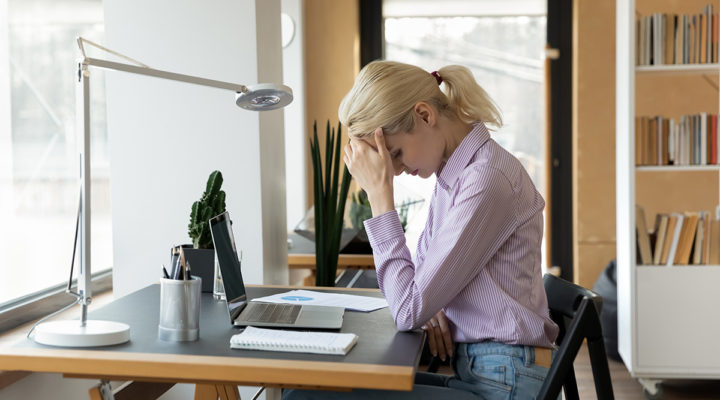Feeling Emotionally Exhausted? A Burnout Expert Explains How Women Can Manage Workplace Stress

Ever since the World Health Organisation classified burnout as an ‘occupational phenomenon’, it’s become a major talking point in the world of wellness.
Left unchecked, the signs of burnout can creep up on us with little warning, causing anxiety, insomnia, brain fog and fatigue. The recent rise of ‘hustle culture’ – a post-pandemic phenomenon which suggests we should be working as hard as we possibly can – has only added fresh fuel to the burnout conversation.
Add a hostile job market, a housing crisis and a looming recession into the mix, and it’s little wonder that 77% of people have experienced burnout at their job, and 42% have left their jobs entirely because they felt burned out.
Amelia Nagoski is an author whose work focuses on the science of female burnout – why it happens and what we can do to overcome it. Along with her sister Emily Nagoski, she is co-author of the New York Times bestselling book Burnout: The Secret to Unlocking the Stress Cycle, which examines women-specific strategies for solving stress.
To help us better understand burnout, we asked Nagoski to give us the lowdown on recovering from chronic stress and how to prevent it from happening in the first place.

Why burnout happens
In the UK, reports of burnout among workers have almost doubled over the past year – hitting record levels. According to statistics, women are slightly more at risk of the issue too. So why are we more exhausted than ever? “Burnout is a result of unceasing demands and unmeetable goals, “ explains Nagoski. ”There’s a constant pressure to be ‘more’ at work, home, and among our community, so we pour from our cup until we have nothing left.”
Nagoski says that many women live with an “unbridgeable chasm” between who they are and what the world expects them to be, creating “tension that compounds the external pressure.” And since they can rarely meet all the goals or fulfill the demands? “They get stuck in a state of stress with no chance to move through it and back into a state of safety.”
Burnout is everywhere, and Nagoski says it’s made worse by the pandemic. The increase in working hours, alongside the stress of moving to remote work and a rise in redundancies, are all likely to have contributed to post-pandemic burnout. “On top of that, there is a constant barrage of social media and advertising content promoting ‘aesthetic ideals’ that are impossible to achieve, whether that’s unrealistic body proportions, beauty standards or relationship ideals.”
The signs can be subtle
The NHS notes that common symptoms of burnout include feeling overwhelmed, irritability, difficulty concentrating and struggling to sleep at night. While the odd stressful situation is a normal part of life, It’s important to be aware of when constant low-level stress might be tipping us over into crisis.
“I define burnout as feeling overwhelmed and exhausted, yet still worried you’re not doing enough,” says Nagoski. “If this sentence rings true for you, you might be burning out.”
She adds: “It’s important to remember that burnout isn’t a medical condition or a mental health diagnosis. It’s an issue caused by a disconnect between you and your environment, not by a failure of your body or mind.”

Tackling the issue
Recognising and prioritising your needs is an important first step in addressing burnout. “Turn toward your discomfort,” advises Nagoski. “It’s human instinct to distract ourselves from discomfort and keep pushing through the pain. Send your attention to the places in your mind and body that are overwhelmed, and notice them without judging yourself.”
The next step is to ‘own’ your burnout. “Learn that your discomfort doesn’t make you weak or broken,” says Nagoski. “When you get comfortable with your burnout, you’ll be able to recognise what your body and mind need. “Tuning into your body is the best way to find the solution you need to manage your stress.”
Examples of stress-based solutions could be asking for reduced work hours, speaking to your boss about your workload or simply learning to set boundaries and say ‘no’ to working overtime.
Self-care has been touted as a tool for solving burnout, but Nagoski believes it’s leaving women more frustrated and unfulfilled than ever. “Frankly, most of the stress management advice in the mainstream media is dangerously unhelpful,” she notes. While running a bath might help you relax in the short term, it won’t solve the root cause of your stress cycle.
“Self-care has become a product to be sold,” believes Nagoski. “The idea that self-care can cure burnout is dangerous. It suggests that it’s women’s fault and that we need to self-care ourselves into wellness. It makes us strive harder, spend more money and adds fuel to the fire.”
“The cure for burnout is not self-care,” she continues. “Rather than perpetuating the myth that women should take care of their stress privately, where they won’t disturb anyone else, we need to recognise that external pressures often burn us out. We don’t need to work harder and do more to meet self-care goals. Wellness happens when we live in a community that tells us we are safe and worthy as we are.”


















